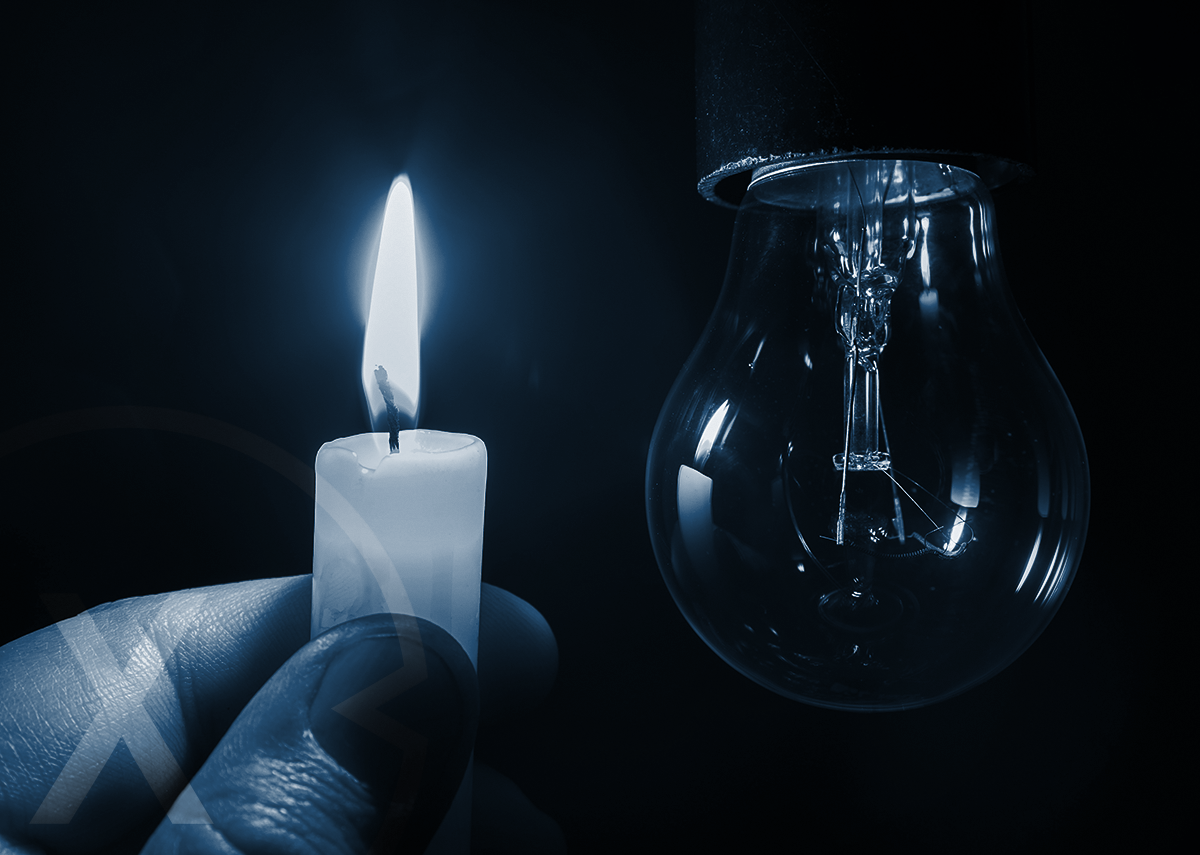
Power storage & hybrid inverter black start – Image: Xpert.Digital / Yevhen Prozhyrko|Shuttterstock.com
Black start means, among other things, the restoration of the operation of a power grid after a complete or partial shutdown without having to resort to the external power transmission network.
Black start capability for hybrid inverters means that if there is a grid failure, the emergency power is still activated and the power is drawn from the battery. This variant requires an additional network switchover.
Hybrid inverter and black start capability
Most inverters are not black start capable. With some inverters it is possible to black start them by charging the separate battery before turning on the inverter. However, this is not always possible and depends on the type of inverter.
The new black start-up hybrid inverter generation has a switch-off device for replacement current, so that selected consumers can continue to be supplied with emergency electricity in the event of a network failure. This “replacement current” enables the hybrid inverter to be canceled black. Solar reloading is also given, in which the battery is forwarded during the network failure to supply consumers with electricity.
Fronius Prim GEN24 Plus hybrid inverter series
The Fronius Prim GEN24 Plus hybrid inverter series is black start capable - Image: Xpert.Digital / Sergey Nivens|Shutterstock.com
The Fronius Prim GEN24 Plus hybrid inverter series is black start capable.
GoodWe Hybrid Inverter 5-10KW ET Plus Series
Hybrid inverter for home and power storage – from GoodWe – Image: Xpert.Digital / Sergey Nivens|Shutterstock.com
The GoodWe hybrid inverter 5-10KW ET Plus series with high-voltage emergency power function (UPS). In the event of a power failure, switching occurs within 10 milliseconds to guarantee an uninterrupted power supply for connected consumers.
The three-phase hybrid inverters of the GoodWe ET-Plus series were developed to guarantee a stable power flow for connected consumers. These devices have a three-phase emergency power output with three-phase current and a power range of 5 kW, 6.5 kW, 8 kW and 10 kW.
The wide battery voltage range from 180 V to 550 V enables flexible compatibility with multiple lithium battery systems on the market.
The incoming PV generator power can be up to 30% higher than the nominal power. This results in better energy yield on hot and very cold days. The UPS (emergency power) function enables switching within 10 milliseconds in the event of a power failure. The inverter also has an open battery management interface, which meets the requirements of some energy suppliers.
The GoodWe hybrid inverter is equipped with a high-voltage battery connection and two separately independent MPP trackers, thus offering a complete package. This device can be kept up to date via the GoodWe PV Master app and the data is transmitted to the free GoodWe SEMS portal via the integrated WiFi interface.
Are HUAWEI inverters capable of emergency power?
No, at the moment we don't know anything about whether and when something will happen in this regard.
Is Enphase microinverter solar technology capable of providing emergency power?
In contrast to a string inverter, which records all connected solar modules (centrally), in a decentralized solar system each solar module is combined with an Enphase micro inverter.
More about it here:
The IQ System Controller from Enphase is not yet available in Germany. But it should come this year (2023). It detects when the power grid goes down and seamlessly switches the home from grid power to backup power.
Additionally, with the new Enphase IQ8 microinverter, the solar system is capable of providing backup power in the event of a power outage without the need for battery storage.
The microinverter is available in four versions: as a solar-only version without emergency power function and as a sunlight backup version with the ability to operate off-grid without battery storage. The system is also available in combination with a small battery storage in the Home Essentials backup version and with large storage as a full energy independence version. All three of the latter off-grid solutions must be equipped with an Enphase System Controller to provide solar power to the home during a power outage.
Xpert hybrid inverter shop
Black start - What is meant by black start capability
A black start is the restoration of operation of a power plant or part of a power grid after a complete or partial shutdown, without having to resort to the external power transmission network.
The energy to restart a power plant can come from an on-site standby generator. Alternatively, if a large amount of electricity is required, a connection line to another power plant can be used to put the system into operation. Once the main generating units are operational, the power transmission network can be reconnected and electrical loads restored.
Black start power can be secured through an agreement whereby a specific energy supplier is paid to provide black start power when needed. Not all power plants are suitable for providing black start power to a grid.
The black start capability is particularly important in the event of a widespread power outage in order to get the energy network back into operation. Normally, the power required to start an energy generation unit is taken from the network. The energy of generating units capable of black start can then be used to start up generating units that are not capable of black start.
Unlike hydroelectric power plants, thermal power plants require a high level of (electrical) energy for their own needs before they can provide electrical or thermal power themselves. If a coal-fired or nuclear power plant block is provided with a black-start unit with sufficient power, black-start capability can also be achieved for the entire system. These are usually gas turbines that are put into operation in black start using energy from accumulators or diesel generators. Diesel generators are often present in nuclear power plants anyway for reasons of redundancy, since even after the reactor is shut down in an emergency (or simply a regular shutdown), decay heat still occurs, which has to be dissipated by the coolant. The failure of this system was one of the aspects that led to the Fukushima nuclear accident. In each network, a sufficient number of power plants must be equipped with black start capability in order to be available for rapid network restart after a network collapse.
A black-start power plant should have special characteristics:
- It should be able to start quickly: if the black start takes a long time, then the power plant cannot help restart a collapsed network; Other power plants could help him out with the start - his black start ability is then useless.
- It must be able to work independently of external power sources: Not only the pure power generation process, but also other ancillary requirements must function independently of the network (control center, telephone and communication systems with network operators and management, substation, etc.). If necessary, island operation with a sub-network is possible (supply of important consumers such as the police, hospital, fire department, THW).
- In addition, a black-start power plant should be able to withstand a high starting current if it was not possible to disconnect it from the grid beforehand.
- It should have flexible starting behavior.
Examples of (direct) black-start power plants used in Germany are:
- Hydroelectric power plants, including run-of-river power plants, storage power plants and pumped storage power plants,
gas turbine power plants, also in combination with other types of power plants such as nuclear power plants or coal-fired power plants.
According to monitoring in accordance with Section 35 EnWG, there are (as of 2020) 174 systems (power plant blocks or turbines) capable of black start in Germany, each of which has a net nominal output of at least 10 MW. - In Austria there are a total of 32 confirmed black-start power plants and an unknown number of unconfirmed black-start power plants. However, for many of the confirmed power plants, it is not publicly known which specific power plants they are. The best known and largest of these are the Malta and Kaprun pumped storage power plants with 850 and 813 MW respectively.
Limitations on Black Start Sources
Not all electricity generation plants are suitable for a black start. Wind turbines are not always suitable for a black start, since the wind may not be available when it is needed. Wind turbines, mini hydropower plants or micro hydropower plants are often connected to induction generators that are unable to provide electricity to restore the network. The black start system must also be stable if it is operated with the large blind load of a long transmission line. Many high-voltage equal power stations (HGÜ) cannot feed into a “dead” network because they need commutation energy from the network on the load page. This restriction does not have a HGÜ system based on pulse width modulation (PWM) with voltage source converter.
A major reason why thermal power plants are rarely capable of black starts is the contraction and shortening of the turbine shaft as it cools from its operating temperature to ambient temperature. It then gets stuck in the housing and can neither be turned nor removed; To restart the power plant, it must first be preheated so that it can rotate freely again before the hot steam can flow through it.
If a thermal power plant is shut down, heating of the turbine shaft begins in good time so that the power plant can be put back into operation at the planned time.
- Plan photovoltaics for warehouses, commercial halls and industrial halls
- Industrial plant: Plan a photovoltaic open-air system or open-space system
- Plan solar systems with photovoltaic solutions for freight forwarding and contract logistics
- B2B solar systems and photovoltaic solutions & advice
With Xpert.Solar your individual solar system advice
I would be happy to serve as your personal advisor.
You can contact me by filling out the contact form below or simply call me on +49 89 89 674 804 (Munich) .
I'm looking forward to our joint project.
Xpert.Digital – Konrad Wolfenstein
Xpert.Digital is a hub for industry with a focus on digitalization, mechanical engineering, logistics/intralogistics and photovoltaics.
With our 360° business development solution, we support well-known companies from new business to after sales.
Market intelligence, smarketing, marketing automation, content development, PR, mail campaigns, personalized social media and lead nurturing are part of our digital tools.
You can find out more at: www.xpert.digital – www.xpert.solar – www.xpert.plus

